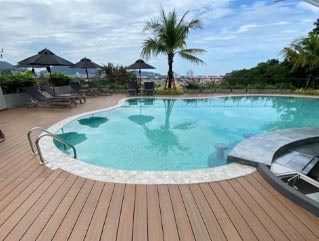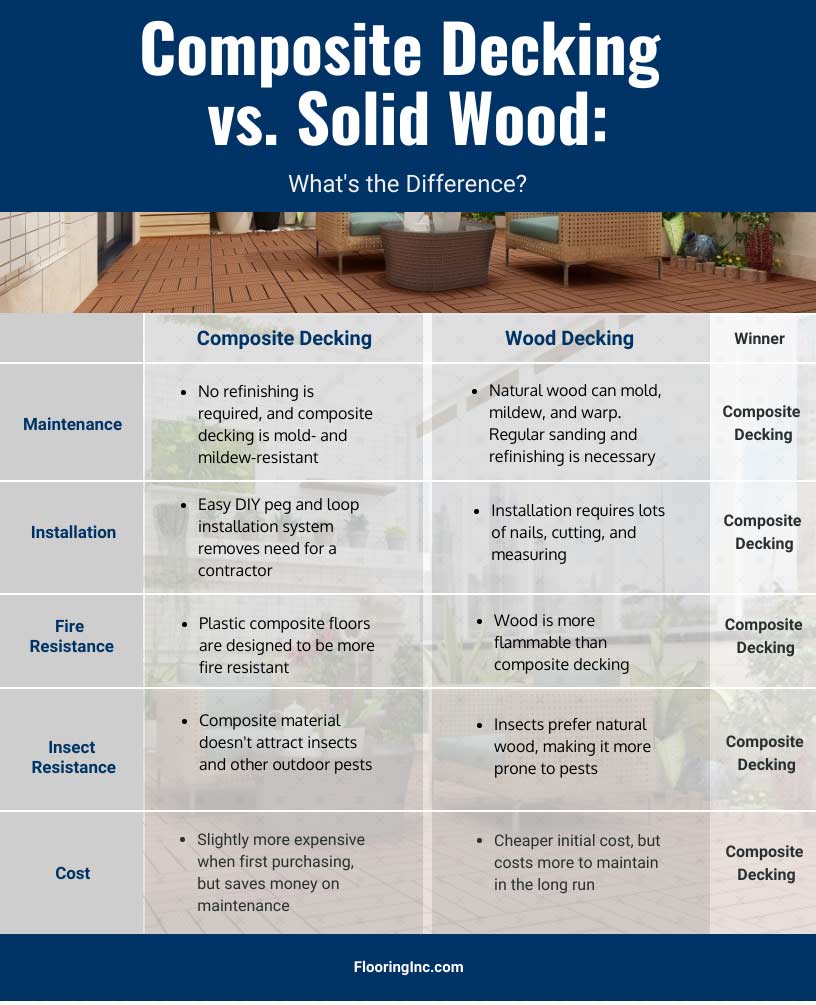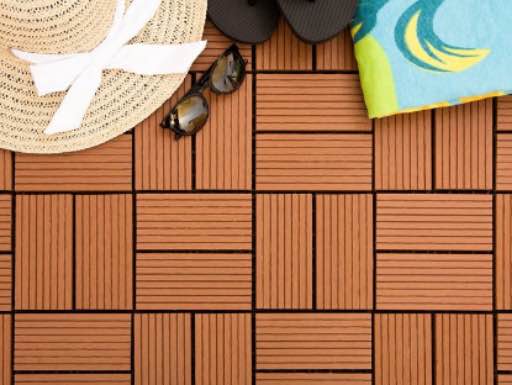Shop Composite Decking

Composite Deck Tiles
- Easy installation
- Modern deck design
- Mold- and mildew-resistant
Shop Composite Deck Tiles

Composite Deck Boards
- Most realistic wood look
- Variety of color options
- Scratch- and fade-resistant
Shop Composite Deck Boards

All Composite Decking
- Low-maintenance
- Weather- and water-resistant
- Eco-friendly
Shop All Composite Decking
Customer Favorite Composite Decking
Composite Decking Reviews
Why Choose Composite Decking?
With composite decking, you can relax on a beautiful deck without the hassle of maintaining it.
Durable and made to last, the best composite products simulate the beautiful appearance of natural wood without the maintenance and upkeep. Instead of logging hours building, staining, or re-sanding your deck, you’ll actually have more time to relax and enjoy it!
And that’s not the only reason to love it. Discover even more benefits.
Durable and made to last, the best composite products simulate the beautiful appearance of natural wood without the maintenance and upkeep. Instead of logging hours building, staining, or re-sanding your deck, you’ll actually have more time to relax and enjoy it!
And that’s not the only reason to love it. Discover even more benefits.

Eco-Friendly
Made from recycled wood and plastic, this is a sustainable outdoor flooring option that will benefit the planet as much as if benefits you.
Shop Eco-Friendly

Easy to Install
If you’re a fan of DIY projects, then you’ll love this decking. In a matter of hours you can snap in together and completely revamp your deck, no contractor required.
Shop DIY-Friendly

Weather-Resistant
Sleet, snow, hail, and UV radiation from the sun can take a toll on outdoor flooring. This decking is built to thrive even in the harsh elements.
Shop Weather-Resistant

Water-Resistant
Instead of absorbing water and warping, composite decking is designed to drain moisture and provide a slip-resistant surface.
Shop Water-Resistant

Mold- and Mildew-Resistant
This decking will remain clean and hygienic even after extended exposure to moisture. You can expect it to look just as good and resist rot for years to come.
Shop Mold- and Mildew-Resistant
Composite Decking FAQ
All About Composite Decking
Composite decking has taken over the world of outdoor flooring, and for good reason. Manufacturers have developed new products that outperform wood on virtually every metric.
There are tons of options to choose from in terms of color, look, and slats. So it might be a bit intimidating when you’re first researching the best options.
Don’t worry though! To help you make your decision, you can learn the pros and cons, FAQs, installation details, and much more. Let’s get started!
There are tons of options to choose from in terms of color, look, and slats. So it might be a bit intimidating when you’re first researching the best options.
Don’t worry though! To help you make your decision, you can learn the pros and cons, FAQs, installation details, and much more. Let’s get started!
What is Composite Decking?
Composite decking is a man-made material, composed of recycled wood fibers/bamboo, recycled plastic, and glue composite. This unique construction makes composite decking durable, low-maintenance, weather-resistant. It’s the perfect solution for outdoor flooring.
This alternative to natural wood decking is becoming the fastest-growing decking option on the market. So, what is it that homeowners love about this new trend?
This alternative to natural wood decking is becoming the fastest-growing decking option on the market. So, what is it that homeowners love about this new trend?
Types of Composite Decking
There are two main types of composite decking: tiles and boards. They each have unique advantages. Read more to find out which option is best for you.
Composite Deck Tiles
These stylish tiles come in a wide range of pattern options, so you can introduce some geometric design to your outdoor space. Deck tiles are also incredibly easy to install. All you have to do is snap them together, and you’re done.
The great thing about deck tiles is that you can create more custom patterns, like checkerboards or stripes, which allows you to design a completely unique space.
Plus, deck tiles are typically a little bit cheaper than boards.
Shop Composite Deck Tiles
The great thing about deck tiles is that you can create more custom patterns, like checkerboards or stripes, which allows you to design a completely unique space.
Plus, deck tiles are typically a little bit cheaper than boards.
Shop Composite Deck Tiles
Composite Deck Boards
With composite deck boards, you’re getting the most realistic wood-look decking without buying the real thing. You can choose from a range of gorgeous wood-look surfaces, and enjoy the easier maintenance and scratch-resistance compared to actual hardwood.
Deck boards are still DIY-friendly, though the process isn’t quite as simple as for tiles. Additionally, composite deck boards tend to be slightly pricier, but those stylish wood visuals are worth it if it fits your budget.
Shop Composite Deck Boards
Deck boards are still DIY-friendly, though the process isn’t quite as simple as for tiles. Additionally, composite deck boards tend to be slightly pricier, but those stylish wood visuals are worth it if it fits your budget.
Shop Composite Deck Boards
Composite Decking Pros and Cons
What are the advantages?
- Weather-Resistant: Deck tiles are built to withstand everything that Mother Nature can throw at them, from snow and rain to the beating sun.
- Durable: Composite deck flooring resists rot, and is manufactured to be more durable than real wood.
- Water-resistant: The tiles won’t easily absorb water, and they’re designed with slats to optimize draining.
- Mold and Mildew-Resistant: Since it doesn’t absorb water easily, it’s much less likely to mildew or get moldy. Huge plus!
- Low-Maintenance: It doesn’t need to be sanded, painted, or sealed regularly like natural wood decks. Wood can require hours of labor-intensive maintenance.
- Insect Resistant: Bugs and other pests will move on to bother other lawns when they discover they can’t burrow and chew on your new deck.
- Eco-Friendly: The eco-friendly recycled materials make this a great option for people focused on sustainability. It’s a more environmentally friendly option compared to traditional lumber decking.
- Resists Fading and Staining: It is made to withstand the bright sun, and won’t readily soak up stains. That means it can maintain that brand-new appearance for years to come.
- Easy to Install: Tiles feature a user-friendly interlocking system that goes together like a puzzle.
What are the drawbacks?
- Heat: Composite decking is made from plastic, and plastic can get hot in the sun. That’s just a fact. Fortunately, you can reduce the risk of too-hot decking by choosing a lighter color and keeping the area well-shaded.
- Up-Front Cost: While you will definitely save in the long run, this decking is more expensive than natural wood when you first make your purchase. However, after a few years without having to seal or resand, this stuff practically pays for itself.
How to Install Composite Decking
Your deck doesn’t have to take the whole summer to build! With composite tiles or boards, you can enjoy a DIY-friendly project that will transform your outdoor space. No matter which option you choose, we’ve got step-by-step instructions to make your project a success.
Installing Composite Deck Tiles
Because composite deck tiles interlock, they’re incredibly user-friendly and easy to install.- When you’re ready to install your composite deck tiles, start with a clean, level subfloor. They work with subfloors such as concrete, asphalt, wood, grass, compacted gravel, and crushed granite.
- Start in the front left corner and make sure the sides of the tile with loops are facing away from the edge. Align the pegs of one tile with the holes of the adjacent tile and set them in.
- Work your way around the edges of the deck, creating a perimeter with the tiles. Then fill the rest of the space.
- If you run into any walls or barriers, measure the gap between the last full tile and the wall. Then, cut the tile accordingly with a table saw, jigsaw, or tile cutter. Use a composite material blade when making the cuts. When doing so, be sure to add a 3/4” space between the tile and all edges to allow for expansion and contraction.
- If your product comes with edge pieces, snap these onto the tiles to complete the installation.
Installing Composite Deck Boards
While deck boards are a bit trickier to install compared to tiles, you can still do it all on your own – no contractor needed.- Start with a stable and level foundation. Often, you will need to build this foundation from breaker boards in a composite decking kit.
- Clips are an essential part of this installation. Attach clips to the deck boards with a power drill and screws
- Once clips are installed on the boards, secure the boards to the deck foundation with screws or nails.
- Gently press an adjacent board to the secured board until the clips lock together.
- To make cuts, start by measuring the gap between the last full board and the wall. Use a table saw, jigsaw, or tile cutter to cut the board. Make sure to use a composite material blade when making the cuts. When doing so, be sure to add a 3/4” space between the board and all edges to allow for expansion and contraction.
- Continue installing clips and locking boards together, then securing them down, until the whole decking surface is complete.
Maintenance
One of the key perks of choosing composite over natural wood is the low maintenance required to keep its beautiful appearance. Plenty can go wrong with natural wood - yearly sealing treatment, termites, wood rot…no thank you!
Composite wood decking tiles are easy to clean and maintain. When your deck gets dirty, simply sweep up any loose crumbs, dust, or debris. Then, hose it off or mop up stains with a mild soap-and-water mixture. Voila!
Composite wood decking tiles are easy to clean and maintain. When your deck gets dirty, simply sweep up any loose crumbs, dust, or debris. Then, hose it off or mop up stains with a mild soap-and-water mixture. Voila!
Composite Decking Vs. Wood Decking
In the past, natural wood was the go-to material for decking, but composite decking is quickly taking that top spot.
Why? Well, there are a lot of reasons, starting with the fact that composite is easier to install, clean, and maintain. It’s bug-resistant and fire-resistant. Plus, it saves you money in the long run.
Need more data? Here’s a head-to-head comparison between composite and wood. See for yourself what makes composite a better and cheaper option than traditional wood decking.
Why? Well, there are a lot of reasons, starting with the fact that composite is easier to install, clean, and maintain. It’s bug-resistant and fire-resistant. Plus, it saves you money in the long run.
Need more data? Here’s a head-to-head comparison between composite and wood. See for yourself what makes composite a better and cheaper option than traditional wood decking.





